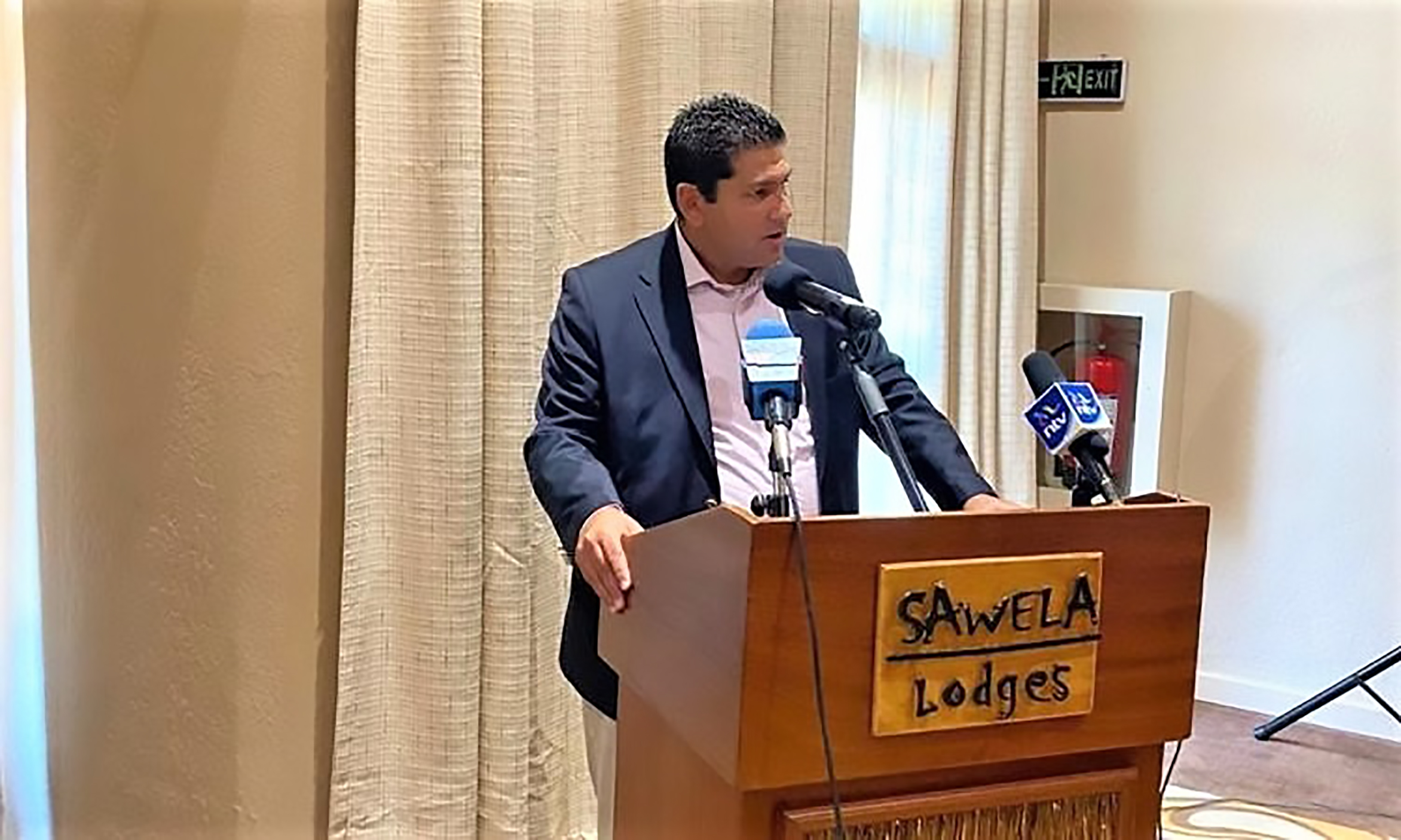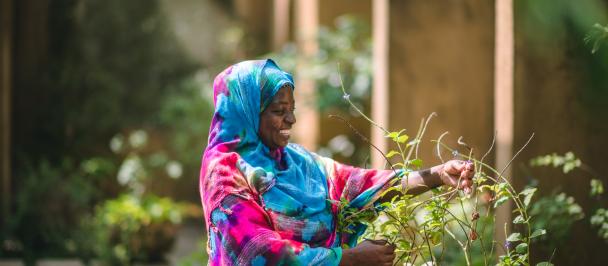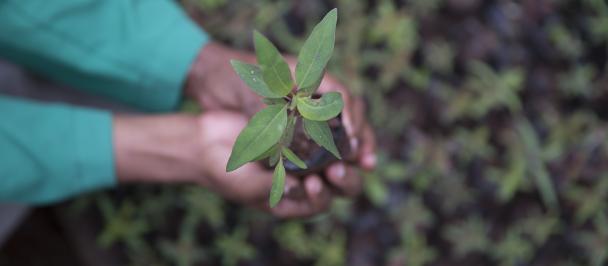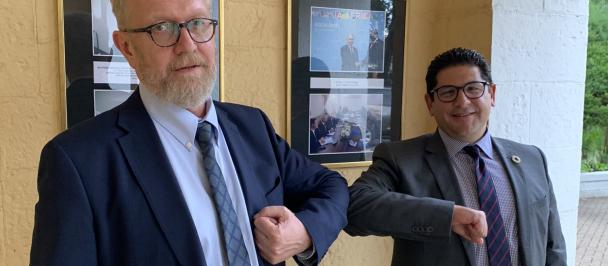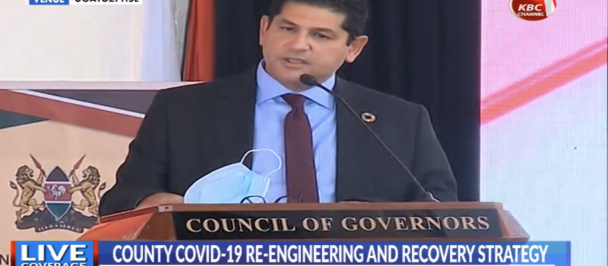UNDP Resident Representative in Kenya, Walid Badawi, delivers his statement at the inter-ministerial technical committee on the rising water levels in Kenya's lakes (Photo, UNDP Kenya)
[salutations]
It gives me great pleasure to join this workshop on the rise in water levels in the lakes within the Rift Valley.
Let me first congratulate Principal Secretary for Ministry of Environment and Forestry, Dr. Kiptoo for moving with speed to establish this inter-ministerial and inter-agency technical committee to support the Government’s planned response and recovery efforts to this unique and unprecedented rise of water levels in these lakes. We have represented here all the key agencies, ministries and institutions that can provide the required technical inputs to strengthen the outcomes of the study that will be conducted on this matter.
I note that the technical committee has representation from the Ministries of Environment and Forestry, Water, Energy, Tourism and Wildlife, Mining, Devolution, Interior, Agriculture, as well as from the county governments of Nakuru and Baringo, and the Council of Governors. In addition, we have non-state actors like the Red Cross, Academia as well as development partners including the UN system. Without doubt, in this room, we have a wealth of expertise and knowledge that will provide sound technical and scientific advice to the Government of Kenya as it responds to this phenomenon.
Distinguished Guests, Ladies and Gentlemen.
We are acutely aware that the current unprecedented water rise in all the lakes within the Rift Valley is a critical challenge to the people of Kenya. That is why UNDP and the UN system, join the Government of Kenya in affirming our support to the efforts for emergency response, recovery, management and research on the longer-term sustainability of this vital ecosystem. I am pleased to note that on Thursday under the coordination of UN OCHA, the Kenya Humanitarian Partners will be meeting and NDOC is set to make a presentation on the humanitarian aspects of this water rise.
We are acutely aware that the phenomenon of rising water levels on these lakes is is also being reported around the Lake Victoria basin and indeed in other parts of the world. It is a complex crisis which touches several facets of human life - it has:
- led to the current humanitarian crisis with displacement of communities,
- affected livelihoods now and well into the future, and
- it has potentially disastrous environmental impacts, as we see lakes Baringo and Bogoria converging bringing with it long term consequences such as epidemics, loss of biodiversity, permanent changes in livelihood and disruptions to traditional and cultural norms.
We must therefore address this problem holistically with sound evidence to do the very best for the Country and all those affected. This is why I am particularly encouraged to see the multi-stakeholder approach being taken by this technical committee.
This water level rise in Kenya’s lakes comes on the back of an equally debilitating COVID-19 pandemic that has impacted greatly on our economy augmenting the urgent need for expeditious action. The entire infrastructure around Lake Baringo, Lake Nakuru, Lake Naivasha - where we are meeting today - are under threat from this challenge.
Submerged under these waters, is not just the land, trees and infrastructure, but the skeletal framework supporting the economic livelihoods for communities living in these areas. The total collapse of the tourism sector within the region will complicate economic recovery in the region. The agricultural sector has also been severely impacted, with horticultural and agricultural lands being submerged. Entire swathes of wildlife habitats are threatened from disappearing, endangering wildlife residing in these areas.
The challenge is compounded as we are just entering Kenya’s short rainy season October – November – December. This problem may get even more difficult with the rainy season although the “La Nina” weather pattern may offer some respite as rainfall in this region may be projected to be lower than usual due to this regular occurrence.
The work of this technical committee is therefore very critical and urgent. UNDP with support from USAID is pleased to partner with the Ministry of Environment and Forestry in supporting this urgent endeavour. Using our integrator role in the UN, we will make every attempt to bring on board the UN family in Kenya to tap into the wide technical expertise and international experience resident in these agencies, UNESCO with its vast hydrological technical expertise is already part of this process but the multidimensional impacts requires us to reach out to many other UN agencies, a process that we have already initiated through our distinguished UN coordination structures in Kenya.
Distinguished Guests, Ladies and Gentlemen.
Scientists have given different explanations for the phenomenon. The explanations range from siltation and increased rainfall to the shifting of tectonic plates deep in the earth’s crust.
We believe that with your technical inputs during this meeting and the assessment work that will follow, Kenya we will get to the bottom of this and be better positioned to fully understand the phenomenon, the impact it is having and the upcoming risks related to the same which will point us in the right direction to address this challenge holistically. I firmly believe Kenya will emerge even stronger from this situation.
Often disasters prove to be a wakeup call to us all, they force us to reflect on what went wrong, what can be done differently in the future and they open up new opportunities for us to build resilience. Let me remind us that we in the United Nations system, continue to celebrate Kenya for being a global sustainable development powerhouse and an acknowledged leader in environmental management. We continue to note and appreciate the transformative steps and measures implemented by Kenya, that continue to expand the pathways to realizing sustainable development as enshrined in the Sustainable Development Goals.
Kenya continues to be a global conservation powerhouse with rich biodiversity ecosystems that straddle the four corners of the country. The diversity of these rich environmental resources is real and breathtakingly beautiful, and we must protect them.
Distinguished Guests, Ladies and Gentlemen,
The beauty in Kenya’s rich blend of lakes that are now spilling over posing real, reminds us of one important thing, climate change is real! As many of us know, while the changing global climates portend immense challenges to Sub-Saharan Africa, they also provide important opportunities for transformational actions that can reduce global carbon emissions; while at the same time touching the livelihoods of local communities. We therefore acknowledge Kenya for her ambitious Nationally Determined Contributions submitted to the UNFCCC, and still urge that more can be done to realize even more benefits for a greener future that should guide Kenya’s recovery strategy from the Covid 19 pandemic.
UNDP, and the wider UN system, is already working with the national and county Governments in charting this course for a “new normal” through our support to the national Socio-Economic Recovery Strategy as well as the County Level Socio-Economic Re – Engineering and Recovery Strategy. We are building on Kenya’s remarkable achievements and resilience, to unlock sustainable development opportunities for all Kenyans. I wish to thank our partners, USAID, through who’s support we are able to facilitate this initiative
Distinguished participants, as I conclude, I am convinced that we have all that it takes to understand and find long term sustainable solutions to this problem.
- We have the science and knowledge from both global and national research;We have the political will;
- We have put in place a multi-sectoral and multi-stakeholder approach;
- We have the catalytic resources to get started and, I am sure, we will mobilize the needed resources for the long-term
- We are guided by the SDGs as our compass to ensure that we leave no one behind and address this challenge in an integrated manner for both the short and long-terms through a risk informed lens.
I reiterate UNDP’s, and indeed the wider UN’s, keen interest to sustaining the partnership that has seen Kenya continue to remain an important global icon for environmental sustainability.
This is what Nobel Laureate Prof. Wangari Maathai would have wanted to see, and this is what we are all working towards.
I thank you all. ASANTENI.

 Locations
Locations